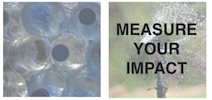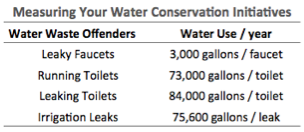 The Green Team ROI Tracker, True Impact’s latest web-based measurement tool, helps calculate the impact of employee-led sustainability projects. This series provides step-by-step instructions for how you can measure the impact of your own Green Team initiatives, using frameworks embedded in the ROI Tracker.
The Green Team ROI Tracker, True Impact’s latest web-based measurement tool, helps calculate the impact of employee-led sustainability projects. This series provides step-by-step instructions for how you can measure the impact of your own Green Team initiatives, using frameworks embedded in the ROI Tracker.
With analysts forecasting a 40% global water shortfall by 2030 and a host of associated financial, regulatory, and reputational risks to business, companies are increasingly attentive to strategies for tracking and conserving water.
The following organizations offer a range of useful resources:
- The World Business Council for Sustainable Development (WBCSD) has many resources for water sustainability at work. In collaboration with Irbaris, IRRC Institute and Ceres, WBCSD developed a free excel-based tool, Ceres Aqua Gauge, to help companies assess, benchmark and advance their water management approach.
- For a tactical guide to conservation, WaterUseItWisely.com provides 100 Ways to Conserve Water.
- The EPA WaterSense program lists many resources to help corporations save water. The Fix A Leak Week encourages individuals and companies to check fixtures and irrigation systems for leaks (Download the Fix A Leak Week PDF). They also certify water-efficient products and appliances through the WaterSense program.
- The Global Environmental Management Initiative (GEMI) has developed a water sustainability tool to help you better understand and guide your own organization's relationship to water.
Strategies for Tracking & Measuring Excess Water Use
Regardless of what strategies your organization adopts, tracking and measuring your activities and water-reduction impacts is key to proving, and improving, the value of those strategies. Here are four simple examples of how to conserve water and measure changes in water use.
Tighten Leaky Faucets
According to the EPA’s WaterSense program, a leaky faucet can waste more than 3,000 gallons per year.
How to measure:
Count each sink that is leaking water from the faucet or the base of the spigot, and multiply that number by 3,000 gallons per year. This calculation assumes water leakage of one-drip-per-second, so if a faucet drips rapidly (two drips per “Mississippi”), multiply your result by 2.
(If you’re using our Green Team calculator, count that faucet as two faucets in the calculator).
2. Stop Running Toilets
A constantly running toilet uses 200 gallons of water or more every day – the equivalent of washing 20 loads of laundry. (Source: U.S. Geological Survey's (USGS) Water Science)
How to measure: If you can hear water cycling through a toilet after the bowl is full, count it as a running toilet. Multiply the number of running toilets at 200 gallons per day by the number of days running to calculate annual water loss.
Leaking toilets are also called “silent leaks,” often caused by a broken or degraded flapper that leaks water from the toilet tank to the bowl. A silent leak can waste up to 7,000 gallons of water per month. (Source: EBMUD Water Smart Tips)
How to measure:
To test for leaks, add about 6 drops of food coloring in the toilet tank and leave it for a half an hour. If the water in the bowl becomes tinted, you have a leak between the tank and the bowl. Check and replace toilet flappers that may be causing leaks, and count each leak at 84,000 gallons lost per year.
4. Seal Irrigation Leaks
The U.S. EPA WaterSense program calculates that a running irrigation system with a leak the thickness of a dime can waste about 6,300 gallons of water per month. Here are two options for measuring a leaking irrigation system.
How to measure:
a. Flow meter With permission of your buildings and grounds or facilities manager, turn off the main cut-off to isolate the irrigation system from the water supply. Using the system’s flow meter, determine if the system continues to use water. The flow meter will alert you to leaks and measure the amount of water lost.
b. Counting Leaks If you cannot measure a leak through the water meter, check irrigation tubes for leaks, nozzle seals for water, and sprinkler heads for weeping. Count each water leak from the system as one leak, wasting 75,600 gallons per year per leak, according to EPA calculations.

Measure Your Impact with the Green Team ROI Tracker
True Impact’s Green Team ROI Tracker uses embedded sustainability calculators to quickly provide you with environmental impact data on your Green Team initiatives. The ROI Tracker measures employee environmental impact on water through dollar savings and gallons of water saved. The impact data provided by the Green Team ROI Tracker will help justify your water-reduction efforts and reduce your water risk.
![]()
For more measurement tips for Green Teams, see our comprehensive Green Team ROI Tracker Measurement Guide. To learn more about True Impact’s measurement work, get in touch.


